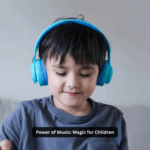From soothing lullabies to joyful jingles, music is often the unseen thread weaving through the fabric of childhood. Yet its role goes far beyond entertainment. Music is increasingly recognized as a powerful therapeutic tool that supports emotional well being, cognitive development, and social bonding in children.
In a world filled with overstimulation, pressure, and rapid change, children need safe, expressive outlets. Music provides just that — a space where feelings can be processed, communication can flourish, and joy can bloom.
🎼 The Connection Between Music and Emotions
Music is universally tied to emotion. A melody can lift our spirits, calm our nerves, or even move us to tears. For children, who may not yet have the vocabulary or maturity to express complex feelings, music becomes a crucial tool for emotional exploration.
-
Joy through Rhythm: Upbeat songs trigger dopamine release, helping children feel happier and more motivated.
-
Calm through Melody: Soft, slow-tempo music lowers cortisol levels, promoting relaxation and reducing anxiety.
-
Expression through Sound: Music gives kids a way to express frustration, sadness, or confusion — even if they can’t explain it in words.
By encouraging emotional literacy through music, we empower children to better understand and regulate their moods, which is essential for healthy relationships and mental resilience.
🧠 Music’s Role in Mental and Developmental Health
Scientific research supports the idea that music doesn’t just make children feel better — it actively helps them develop better. Studies have shown that music can:
-
Improve memory and concentration
-
Enhance motor skills and coordination
-
Support speech and language development
-
Promote social interaction and empathy
Perhaps most importantly, engaging with music nurtures a child’s inner world, strengthening their sense of identity and emotional security.
🏠 Simple Ways to Use Music for Emotional Well Being at Home
You don’t need to be a therapist or musician to use music intentionally in your home. Here are easy ways to nurture your child’s emotional well being through sound:
-
🎤 Morning mood boosters: Start the day with a fun, energetic playlist.
-
🎧 Calm-down time: Play soothing instrumental music during transitions or bedtime.
-
🥁 Family jam sessions: Encourage kids to create their own rhythms using pots, pans, and homemade instruments.
-
🎶 Feelings songs: Make up songs together about how the day felt — silly, sad, exciting, or scary.
These daily rituals can help children anchor their emotions and provide comfort during uncertain moments.
🔗 Dive Deeper into the Power of Music
For an in-depth exploration of how music impacts child development, emotional balance, and mental health, read the article emotional well being. This comprehensive guide uncovers the science behind musical therapy for kids and offers expert insights into how melodies can lead to milestones.
🎹 A Harmonious Future
As the demands on children grow, so must our commitment to their emotional wellness. Music offers an accessible, enjoyable, and proven method to help kids feel seen, heard, and understood. Whether it’s a soft tune to ease anxiety or a drumbeat to spark confidence, every note has the power to heal and uplift.
Let music be the heartbeat of your child’s growth journey — a gentle rhythm guiding them toward a life filled with empathy, self-awareness, and joy.
